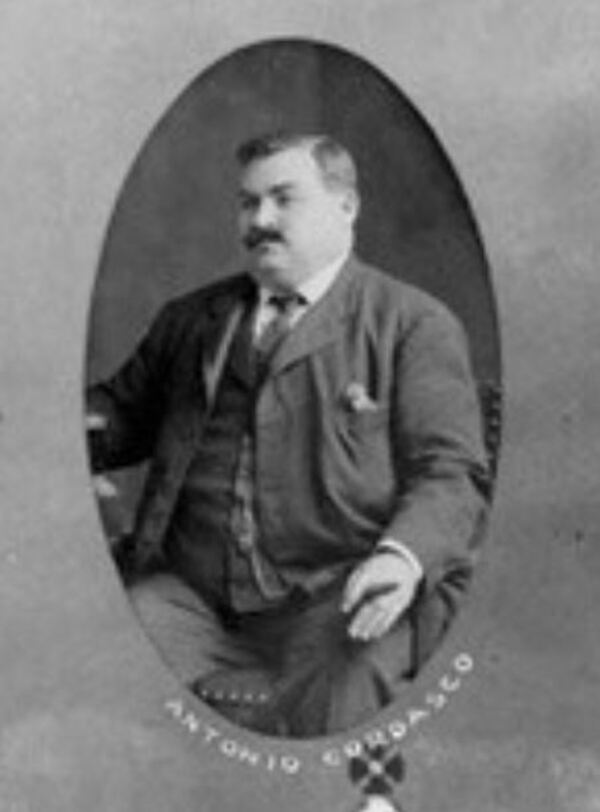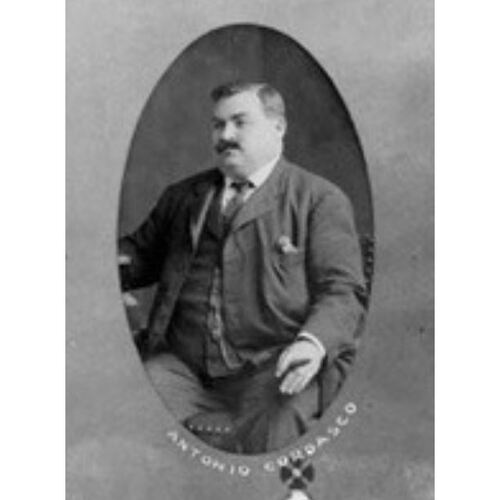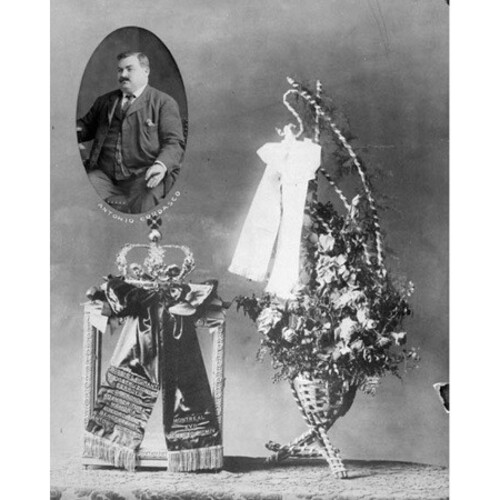
Source: Link
CORDASCO, ANTONIO, labourer, employment agent, banker, and newspaper owner; b. 5 June 1863 in Italy, son of Carlo Cordasco and Tomassina (Tommasina) Gagliardi (Galiardi); m. 16 April 1891 Maria Concetta La Pietra in Montreal, and they had four sons and two daughters; d. there 19 April 1921.
Born most likely in the region of Calabria, Antonio Cordasco arrived in Canada in 1886, when the first contingents of seasonal Italian labourers appeared in the industrial landscape. His early association with railway construction, and no doubt his ambition, allowed him to move up the ranks of the Canadian Pacific Railway’s work crews from labourer to foreman. It was probably as a foreman that he became active in recruiting labourers. In 1901, faced with a major labour conflict, the CPR turned to him for help, offering to pay him a dollar for each strike-breaker he delivered. He was able to meet the challenge by availing himself of contacts with labour-recruiting agencies in a number of northeastern American cities and supplied the CPR with about 2,000 men. As a result, that year he became the CPR’s exclusive recruiter of Italian workers.
During the early 1900s, when the CPR undertook a major expansion of its rail system and developed natural-resource industries along its lines, it was Canada’s leading employer of migrant labourers – most of them unskilled seasonal workers needed for the construction and the maintenance of rail lines. In a typical year several thousand Italian labourers were in its employ, along with several thousand belonging to a variety of other nationalities. The system of recruiting migrant labour had become known throughout North America as the padrone system. Though severely restrained in the United States by federal legislation starting in 1885, the system had been allowed to persist in Canada. Labour recruitment would become subject to strict government regulation only after 1905. During the brief period – in the late 19th and early 20th centuries – when the padrone system was most in vogue in Canada, Cordasco emerged as its leading entrepreneur, largely because of the privileged relations he had established with the CPR.
From the office he set up on Rue Saint-Jacques in Montreal about 1901, Cordasco directed an elaborate network, ranging from recruiters in Italian villages to arrangements with steamship companies which allowed workers to travel on prepaid tickets. Once the workers had arrived in Canada and had paid the one dollar commission Cordasco exacted, they were organized into work gangs and entrusted to gang leaders – associates of Cordasco who were often also foremen for the CPR. Even in remote camps stretching from northern Ontario to British Columbia, labourers afforded Cordasco a source of revenue, since he acted as the exclusive supplier of food commodities, charging from 60 to 120 per cent above cost.
Besides satisfying the workers’ need for jobs, Cordasco provided them with other services. By 1903 he had gone into banking. As a banchista (the term employed at the time for a private banker), he arranged for the transfer of earnings to families in Italy. The Corriere del Canada, a Montreal-based newspaper controlled by Cordasco early in the decade, served more as a tool for his recruiting than as a bona fide community paper. Cordasco, in fact, proved capable of launching particularly aggressive publicity campaigns in order to stave off competition from other Montreal padroni and employment agencies. In one case, on 27 Jan. 1904, he mounted a public event in which some 60 foremen and 2,000 workers marched through Montreal. At the height of the ceremony, his faithful assistants solemnly placed on his head a crown that was a replica of the one worn by the king of Italy, calling him “The King of Italian Labourers.”
In the spring of 1904 thousands of Italian labourers flocked to Montreal in response to advertisements by Cordasco and other padroni. When a late thaw delayed the beginning of the work season, the unemployed men were forced to rely on public charity. At the request of civic authorities, a federal royal commission was appointed to inquire into the immigration of Italian labourers to Montreal and the alleged fraudulent practices of employment agencies. Although several agents in the city testified, Cordasco was a prime target. The proceedings of the inquiry, headed by judge John Winchester, constitute probably the richest documentation on the workings of the padrone system. As a result of the investigation, Cordasco’s reputation suffered significantly. He was drawn into a number of court battles over fees he had exacted and wages he had not paid. The inquiry also led to the termination of his relations with the CPR. Despite the collapse of his recruiting empire, he managed to pursue his activities as a banchista and he acted as a steamship agent. He had become a naturalized British subject in 1902. At his death in 1921, his private banking business was still operating; it was taken over by his son Thomas Antonio (Anthony). Another son, Charles M., had served as a lieutenant in the Royal Flying Corps during World War I and was a prominent foreign exchange broker in Montreal.
One of the most important sources of information on Antonio Cordasco’s activities is Can., Royal commission to inquire into the immigration of Italian labourers to Montreal and the alleged fraudulent practices of employment agencies, Report of commissioner and evidence (Ottawa, 1905), which was published both separately and in Can., Parl., Sessional papers, 1905, no.36b. The French report has been republished as “Document: Rapport de la Commission royale sur l’immigration des journaliers italiens et des procédés frauduleux des bureaux de placement,” introd. Bernard Dansereau, RCHTQ [Regroupement des Chercheurs-Chercheuses en Hist. des Travailleurs et Travailleuses du Québec], Bull. (Montréal), 22 (1996), no.1: 3–39.
BCM-G, RBMS, Notre-Dame de Montréal, 16 avril 1891; Saint-Jacques-le-Majeur (Montréal), 21 avril 1921 (mfm.). LAC, RG 31, C1, 1901, Montreal, Saint-Antoine Ward, sub-dist. A-3: 11. Directory, Montreal, 1906–21. R. F. Harney, “Montreal’s king of Italian labour: a case of padronism,” Labour (Halifax), 4 (1979): 57–84. Gunther Peck, “Reinventing free labor: immigrant padrones and contract laborers in North America, 1885–1925,” Journal of American Hist. (Bloomington, Ind.), 83 (1996–97): 848–71. Bruno Ramirez, Les premiers Italiens de Montréal: l’origine de la Petite Italie du Québec (Montréal, 1984). Paul Tana, Caffè Italia (video recording in French and in Italian with French subtitles, Montreal, 1985).
Cite This Article
Bruno Ramirez, “CORDASCO, ANTONIO,” in Dictionary of Canadian Biography, vol. 15, University of Toronto/Université Laval, 2003–, accessed December 31, 2025, https://www.biographi.ca/en/bio/cordasco_antonio_15E.html.
The citation above shows the format for footnotes and endnotes according to the Chicago manual of style (16th edition). Information to be used in other citation formats:
| Permalink: | https://www.biographi.ca/en/bio/cordasco_antonio_15E.html |
| Author of Article: | Bruno Ramirez |
| Title of Article: | CORDASCO, ANTONIO |
| Publication Name: | Dictionary of Canadian Biography, vol. 15 |
| Publisher: | University of Toronto/Université Laval |
| Year of publication: | 2005 |
| Year of revision: | 2005 |
| Access Date: | December 31, 2025 |




